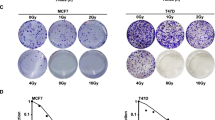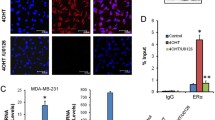Abstract
Estrogen receptor positive breast cancer is the most common type of breast cancer and in most cases, hormone therapy is considered complementary to surgery. Tamoxifen is one of the most common drugs used in hormone therapy for treating estrogen receptor positive breast cancer cells. However, it has severe side-effects depending on the duration of treating breast cancer and amount of tamoxifen used. In this study, we examined the effects of electroporation on the tamoxifen uptake in estrogen receptor positive MCF–7 breast cancer cells. The survival rate of MCF–7 cells had a negative relationship with energy dissipation in cells. Similarly, the electrical charge delivered to cells during electroporation was inversely proportional to survival rate. The combined application of electroporation and tamoxifen is much more effective than the usage of tamoxifen alone in the treatment of estrogen receptor positive breast cancer. The application of electroporation increased the uptake of tamoxifen into MCF–7 cells and reduced the minimal tamoxifen dosage which, is needed for the treatment of estrogen receptor positive breast cancer.





Similar content being viewed by others
References
Yarmush, M. L., Golberg, A., Serša, G., Kotnik, T., & Miklavčič, D. (2014). Electroporation-based technologies for medicine: Principles, applications, and challenges. Annual review of biomedical engineering, 16, 295–320.
Cemazar, M., Kotnik, T., Sersa, G., & Miklavcic, D. (2015). Electroporation for electrochemotherapy and gene therapy in book: Electromagnetic fields in biology and medicine. In M.S. Markov (Ed.) Ch. 24 (pp. 395–413). CRC Press.
Sarmah, J. K., Mahanta, R., Bhattacharjee, S. K., Mahanta, R., Dey, A., Guha, P., & Biswas, A. (2012). In-vitro cytotoxicity analysis of Tamoxifen citrate loaded cross-linked guar gum nanoparticles on jurkat (human T-cell leukemia) cell line. Journal of Drug Delivery and Therapy, 2, 67–70.
Jain, R. K. (1998). Delivery of molecular and cellular medicine in solid tumors. Journal of Controlled Release, 53, 49–67.
Pavlin, M., Pavselj, N., & Miklavcic, D. (2002). Dependence of induced transmembrane potentialon cell density, arrangements, and cell position inside the cell system. IEEE Transactions on Bio-Medical Engineering, 49, 605–612.
Maček-Lebar, A., & Miklavčič, D. (2001). Cell electropermeabilization to small molecules in vitro: Control by pulse parameters. Radiology and Oncology, 35, 193–202.
Teissié, J., & Rols, M. P. (1993). An experimental evaluation of the critical potential difference inducing cell membrane electropermeabilization. Biophysical Journal, 65, 409–13.
Meaking, W. S., Edgerton, J., Wharton, C. W., & Meldrum, R. A. (1995). Electroporation-induced damage in mammalian cell DNA. Biochimica et biophysica acta, 1264, 357–62.
Gehl, J. (2003). Electroporation: Theory and methods, perspectives for drug delivery, gene therapy and research. Acta Physiologica Scandinavica, 177, 437–47.
Dev, S. B. (1994). Killing cancer cells with a combination of pulsed electric fields and chemotherapeutic agents. Cancer Watch, 3, 12–14.
Dev, S. B., & Hofmann, G. A. (1994). Electrochemotherapy-A novel method of cancer treatment. Cancer Treatment Reviews, 20, 105–115.
Lumachi, F., Brunello, A., Maruzzo, M., Basso, U., & Basso, S. M. (2013). Treatment of estrogen receptor-positive breast cancer. Current Medicinal Chemistry, 20, 596–604.
Seeger, H., Huober, J., Wallwiener, D., & Mueck, A. O. (2004). Inhibition of human breast cancer cell proliferation with estradiol metabolites is as effective as with tamoxifen. Hormone and Metabolic Research, 36, 277–280.
Fisher, B., Costantino, J. P., Wickerham, D. L., Redmond, C. K., & Kavanah, M., et al. (1998). Tamoxifen for prevention of breast cancer: Report of the national surgical adjuvant breast and bowel project P–1 study. Journal of the National Cancer Institute, 90, 1371–1388.
Nayfield, S. G., Karp, J. E., Ford, L. G., Dorr, F. A., & Kramer, B. S. (1991). Potential role of tamoxifen in prevention of breast cancer. Journal of the National Cancer Institute, 83, 1450–1459.
Bush, T. L., & Helzlsouer, K. J. (1993). Tamoxifen for the primary prevention of breast cancer: A review and critique of the concept and trial. Epidemiologic Reviews, 1, 233–43.
Brauch, H., & Jordan, V. C. (2009). Targeting of tamoxifen to enhance antitumour action for the treatment and prevention of breast cancer: The ‘personalised’ approach?”. European Journal of Cancer, 45, 2274–2283.
Davies, C., Godwin, J., & Gray, R., et al. (2011). Early Breast Cancer Trialists’ Collaborative Group (EBCTCG) Relevance of breast cancer hormone receptors and other factors to the efficacy of adjuvant tamoxifen: Patient-level meta-analysis of randomised trials. The Lancet, 378, 771–784.
Fisher, B., Costantino, J. P., Wickerham, D. L., Cecchini, R. S., Cronin, W. M., Robidoux, A., Bevers, T. B., Kavanah, M. T., Atkins, J. N., Margolese, R. G., Runowicz, C. D., James, J. M., Ford, L. G., & Wolmark, N. (2005). Tamoxifen for the prevention of breast cancer: Current status of the national surgical adjuvant breast and bowel project P–1 study. Journal of the National Cancer Institute, 97, 1652–1662.
Davies, C., Pan, H., & Godwin, J., et al. (2013). The adjuvant tamoxifen: Longer against shorter (ATLAS) collaborative group Long-term effects of continuing adjuvant tamoxifen to 10 years versus stopping at 5 years after diagnosis of oestrogen receptor-positive breast cancer: ATLAS, a randomised trial. Lancet, 381, 805–16.
Leeuwen, F. E., Benraadt, J., Coebergh, J. W. W., Kiemeney, L. A. L. M., Gimbrère, C. H. F., & Otter, R., et al. (1994). Risk of endometrial cancer after tamoxifen treatment of breast cancer. Lancet, 343, 448–52.
Bergman, L., Beellen, M. L., Gallee, M. P. W., Hollema, H., Benraadt, J., & van Leeuwen, F. E., et al. (2000). Risk and prognosis of endometrial cancer after tamoxifen for breast cancer. Lancet, 356, 881–7.
Chen, G. Y., Conner, A. J., Wang, J., Fautrier, A. G., & Field, R. J. (1998). Energy dissipation as a key factor for electroporation of protoplasts. Molecular Biotechnology, 10, 209–16.
Kavitha, S., Raja Ramachandran, P., Kumar, M.S., Kumar, V.M., Vignesh, S., Malini, V., Renny, C.M., Guhathakurta, S., Cherian, K.M., Natarajan, A., Sundararajan, R. (2010) Electro-molecular therapy using adult mesenchmal stem cells. In Proceedings of the ESA annual meeting on electrostatics (p. I3). University of North Carolina, Charlotte, USA.
Canatella, P. J., Karr, J. F., Petros, J. A., & Prausnitz, M. R. (2001). Quantitative study of electroporationmediated molecular uptake and cell viability. Biophysical Journal, 80, 755–764.
Hui, S.W. & Li, L.H. (2000) In vitro and ex vivo gene delivery to cells by electroporation, In M.J. Jaroszeski, R. Heller, & R. Gilbert (Eds.), Electrochemotherapy, electrogenetherapy, and transdermal drug delivery. Humana Press. New York City, USA.
Lurquin, P. F. (2013). The rate of electrical energy dissipation (power) and the RC constant unify all electroporation parameters. Biotechnology, 3, 331–333.
Lurquin, P. F. (1997). Gene transfer by electroporation. Molecular Biotechnology, 7, 5–35.
Jordan, E. T., Collins, M., Terefe, J., Ugozzoli, L., & Rubio, T. (2008). Optimizing electroporation conditions in primary and other difficult-to-transfect cells. Journal of Biomolecular Techniques, 19, 328–334.
Liang, H., Purucker, W. J., Stenger, D. A., Kubiniec, R. T., & Hui, S. W. (1988). Uptake of fluorescence-labeled dextrans by 10T 1/2 fibroblasts following permeation by rectangular and exponential-decay electric field pulses. BioTechniques, 6, 550 –558.
Prausnitz, M. R., Milano, C. D., Gimm, J. A., Langer, R., & Weaver, J. C. (1994). Quantitative study of molecular transport due to electroporation: Uptake of bovine serum albumin by erythrocyte ghosts. Biophysical Journal, 66, 1522–1530.
Cemazar, M., Jarm, T., Miklavcic, D., Macek-Lebar, A., Ihan, A., Kopitar, N. A., & Sersa, G. (1998). Effect of Electric-Field Intensity on electropermeabilization and electrosensitmty of various tumor-cell lines in vitro. Electromagnetic Biology and Medicine, 17, 263–272.
Pehlivanova, V. N., Tsoneva, I. H., & Tzoneva, R. D. (2012). Multiple effects of electroporation on the adhesive behaviour of breast cancer cells and fibroblasts. Cancer Cell International, 12, 9.
Neal, R. E., Singh, R., Hatcher, H. C., Kock, N. D., Torti, S. V., & Davalos, R. V. (2010). Treatment of breast cancer through the application of irreversible electroporation using a novel minimally invasive single needle electrode. Breast Cancer Research and Treatment, 123, 295–301.
Kulbacka, J., Kotulska, M., Rembiałkowska, N., Choromańska, A., Kamińska, I., Garbiec, A., Rossowska, J., Daczewska, M., Jachimska, B., & Saczko, J. (2013). Cellular stress induced by photodynamic reaction with CoTPPS and MnTMPyPCl5 in combination with electroporation in human colon adenocarcinoma cell lines (LoVo and LoVoDX). Cell Stress & Chaperones, 18, 719–31.
Schmidt, G., Juhasz-Böss, I., Solomayer, E. F., & Herr, D. (2014). Electrochemotherapy in breast cancer: A review of references. Geburtshilfe und Frauenheilkunde, 74, 557–562.
Jarm, T., Cemazar, M., Miklavcic, D., & Sersa, G. (2010). Antivascular effects of electrochemotherapy: Implications in treatment bleeding metastases. Expert Review of Anticancer Therapy, 10, 729–746.
Kotnik, T., Pucihar, G., Rebersˇek, M., Miklavcˇic, D., & Mir, M. L. (2003). Role of pulse shape in cell membrane electropermeabilization. Biochimica et Biophysica Acta, 1614, 193–200.
Matthiessen, L. W., Johannesen, H. H., Hendel, H. W., Moss, T., Kamby, C., & Gehl, J. (2012). Electrochemotherapy for large cutaneous recurrence of breast cancer: A phase II clinical trial. Acta Oncologica (Stockholm, Sweden), 51, 713–21.
Mali, B., Jarm, T., & Snoj, M., et al. (2013). Antitumor effectiveness of electrochemotherapy: A systematic review and meta-analysis. European Journal of Surgical Oncology : The Journal of the European Society of Surgical Oncology and the British Association of Surgical Oncology, 39, 4–16.
Sersa, G., Cufer, T., Paulin, S. M., Cemazar, M., & Snoj, M. (2012). Electrochemotherapy of chest wall breast cancer recurrence. Cancer Treatment Reviews, 38, 379–86.
Benevento, R., Santoriello, A., Perna, G., & Canonico, S. (2012). Electrochemotherapy of cutaneous metastastes from breast cancer in elderly patients: A preliminary report. BMC Surgery, 12, 1–6.
Rebersek, M., Cufer, T., Cemazar, M., Kranjc, S., & Sersa, G. (2004). Electrochemotherapy with cisplatin of cutaneous tumor lesions in breast cancer. Anti-Cancer Drugs, 15, 593–597.
Raeisi, E., Aghamiri, S. M., Bandi, A., Rahmatpour, N., Firoozabadi, S. M., Kâfi-Abad, S. A., & Mir, L. M. (2012). The antitumor efficiency of combined electrochemotherapy and single dose irradiation on a breast cancer tumor model. Radiology and Oncology, 46, 226–232.
Miklavcic, D., Mali, B., Kos, B., Heller, R., & Sersa, G. (2014). Electrochemotherapy: From the drawing board into medical practice. Biomedical Engineering Online, 13, 29.
Matthiessen, L. W., Johannesen, H. H., & Hendel, H. W., et al. (2012). Electrochemotherapy for large cutaneous recurrence of breast cancer: A phase II clinical trial. Acta Oncologica, 51, 713–721.
Gilbert, R. A., Jaroszeski, M. J., & Heller, R. (1997). Novel electrode designs for electrochemotherapy. Biochimica et Biophysica Acta, 1334, 9–14.
Sersa, G., Cemazar, M., & Rudolf, Z. (2003). Electrochemotherapy: Advantages and drawbacks in treatment of cancer patients. Cancer Therapy, 1, 133–142.
Marty, M., Sersa, G., Garbay, J. R., Gehl, J., Collins, C. G., & Snoj, M., et al. (2006). Electrochemotherapy—An easy, highly effective and safe treatment of cutaneous and subcutaneous metastases: Results of ESOPE (European standard operating procedures of electrochemotherapy) study. European Journal of Cancer (Oxford, England : 1990), 4, 3–13.
Mir, L. M., Glass, L. F., & Serša, G., et al. (1998). Effective treatment of cutaneous and subcutaneous malignant tumours by electrochemotherapy. British Journal of Cancer, 77, 2336–2342.
Sersa, G. (2006). The state-of-the-art of electrochemotherapy before the ESOPE study; advantages and clinical uses. European Journal of Cancer, 245, 469–479.
Benevento, R., Santoriello, A., Perna, G., & Canonico, S. (2012). Electrochemotherapy of cutaneous metastastes from breast cancer in elderly patients: A preliminary report. BMC Surgery, 12 Suppl 1, S6.
Author information
Authors and Affiliations
Corresponding author
Ethics declarations
Conflict of interest
The authors declare that they have no competing interests.
Rights and permissions
About this article
Cite this article
Esmekaya, M.A., Kayhan, H., Yagci, M. et al. Effects of Electroporation on Tamoxifen Delivery in Estrogen Receptor Positive (ER+) Human Breast Carcinoma Cells. Cell Biochem Biophys 75, 103–109 (2017). https://doi.org/10.1007/s12013-016-0776-z
Received:
Accepted:
Published:
Issue Date:
DOI: https://doi.org/10.1007/s12013-016-0776-z




